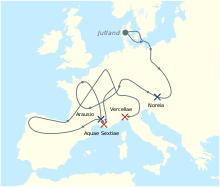Ambrones: Perbedaan antara revisi
Tampilan
Konten dihapus Konten ditambahkan
Tidak ada ringkasan suntingan |
k Moving from Category:Zaman arkeologi to Category:zaman dalam arkeologi using Cat-a-lot |
||
| Baris 20: | Baris 20: | ||
[[Kategori:Prasejarah Eropa]] |
[[Kategori:Prasejarah Eropa]] |
||
[[Kategori:Arkeologi Eropa]] |
[[Kategori:Arkeologi Eropa]] |
||
[[Kategori: |
[[Kategori:zaman dalam arkeologi]] |
||
Revisi per 4 Februari 2023 08.11

X (merah) Kekalahan Cimbri, Ambrones dan Teuton.
X (biru) Kemenangan Cimbri, Ambrones dan Teuton.
Ambrones (bahasa Yunani Kuno: Ἄμβρωνες) merupakan nama dari sebuah suku kuno yang disebutkan oleh para penulis Romawi. Suku tersebut pada umumnya dianggap sebagai suku bangsa Jermanik[1][2] dari Jutlandia.[1]
Lihat pula
Catatan
- ^ a b Hussey, Joan Mervyn (1957). The Cambridge Medieval History. CUP Archive. hlm. 191–193.
It was the Cimbri, along with their allies the Teutones and Ambrones, who for half a score of years kept the world in suspense. All three peoples were doubtless of Germanic stock. We may take it as established that the original home of the Cimbri was on the Jutish peninsula, that of the Teutones somewhere between the Ems and the Weser, and that of the Ambrones in the same neighborhood, also on the North Sea coast.
- ^ "History of Europe". Encyclopædia Britannica Online. Diakses tanggal June 26, 2018.
Even before 200 bce the first Germanic tribes had reached the lower Danube, where their path was barred by the Macedonian kingdom. Driven by rising floodwaters, at the end of the 2nd century bce, migratory hordes of Cimbri, Teutoni, and Ambrones from Jutland broke through the Celtic-Illyrian zone and reached the edge of the Roman sphere of influence, appearing first in Carinthia (113 bce), then in southern France, and finally in upper Italy.
